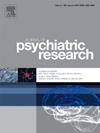Comparing efficacy of serotonergic, opioidergic, and glutamatergic drugs in gambling disorder: A pooled analysis of response trajectories versus placebo
IF 3.7
2区 医学
Q1 PSYCHIATRY
引用次数: 0
Abstract
Various pharmacological treatments have been explored to alleviate the symptoms and clinical manifestations of gambling disorder (GD) by targeting different neurotransmitter systems. This study retrospectively analyzed subjects with GD treated with serotonergic drugs, opioid antagonist drugs, and glutamatergic drugs compared to placebo, through a pooled analysis of clinical trials conducted at the University of Chicago. The Gambling Symptom Assessment Scale (G-SAS) was employed as the outcome measure. Temporal uniformity was ensured by managing timepoints as follows: baseline, early (4–5 weeks), intermediate (6–8 weeks), and final (10–16 weeks) from the start of treatment.
A total of 253 treatment-seeking subjects were included, receiving either glutamatergic drugs (N-acetylcysteine, memantine), opioidergic drugs (naltrexone), serotonergic drugs (paroxetine, escitalopram), or placebo. Within-group analysis demonstrated significant improvement in GD symptoms across all treatment groups. When comparing interventions over time, glutamatergic drugs proved more effective than placebo from the early observation timepoint and onwards. Opioidergic drugs were more effective than placebo at the final observation timepoint, while serotonergic drugs showed no significant effect compared to placebo.
Our findings reveal distinct efficacy patterns among the pharmacological classes, likely due to their different mechanisms of action and the various aspects of GD phenomenology they address. The significant placebo effect observed aligns with previous studies, underscoring the complexity of treating GD. In conclusion, given the heterogeneous nature of GD, these results emphasize the necessity of identifying and precisely characterizing GD subtypes to facilitate more tailored treatment approaches.
比较5 -羟色胺能、阿片能和谷氨酸能药物对赌博障碍的疗效:反应轨迹与安慰剂的汇总分析
通过针对不同的神经递质系统,探索了各种药物治疗来缓解赌博障碍(GD)的症状和临床表现。本研究通过芝加哥大学进行的临床试验汇总分析,回顾性分析了GD患者接受血清素能药物、阿片类拮抗剂药物和谷氨酸能药物治疗与安慰剂治疗的对比。采用赌博症状评定量表(G-SAS)作为结果测量。通过以下时间点管理来确保时间的均匀性:基线,早期(4-5周),中期(6-8周)和最终(10-16周)从治疗开始。共纳入253名寻求治疗的受试者,接受谷氨酸能药物(n -乙酰半胱氨酸、美金刚)、阿片类药物(纳曲酮)、血清素能药物(帕罗西汀、艾司西酞普兰)或安慰剂。组内分析显示,所有治疗组的GD症状均有显著改善。当比较不同时间的干预措施时,从早期观察时间点开始,谷氨酸能药物证明比安慰剂更有效。在最终观察时间点,阿片类药物比安慰剂更有效,而血清素能药物与安慰剂相比无显著作用。我们的研究结果揭示了不同药理学类别之间的不同功效模式,可能是由于它们不同的作用机制和它们所处理的GD现象的各个方面。观察到的显著安慰剂效应与先前的研究一致,强调了GD治疗的复杂性。总之,鉴于GD的异质性,这些结果强调了识别和准确表征GD亚型的必要性,以促进更有针对性的治疗方法。
本文章由计算机程序翻译,如有差异,请以英文原文为准。
求助全文
约1分钟内获得全文
求助全文
来源期刊

Journal of psychiatric research
医学-精神病学
CiteScore
7.30
自引率
2.10%
发文量
622
审稿时长
130 days
期刊介绍:
Founded in 1961 to report on the latest work in psychiatry and cognate disciplines, the Journal of Psychiatric Research is dedicated to innovative and timely studies of four important areas of research:
(1) clinical studies of all disciplines relating to psychiatric illness, as well as normal human behaviour, including biochemical, physiological, genetic, environmental, social, psychological and epidemiological factors;
(2) basic studies pertaining to psychiatry in such fields as neuropsychopharmacology, neuroendocrinology, electrophysiology, genetics, experimental psychology and epidemiology;
(3) the growing application of clinical laboratory techniques in psychiatry, including imagery and spectroscopy of the brain, molecular biology and computer sciences;
 求助内容:
求助内容: 应助结果提醒方式:
应助结果提醒方式:


